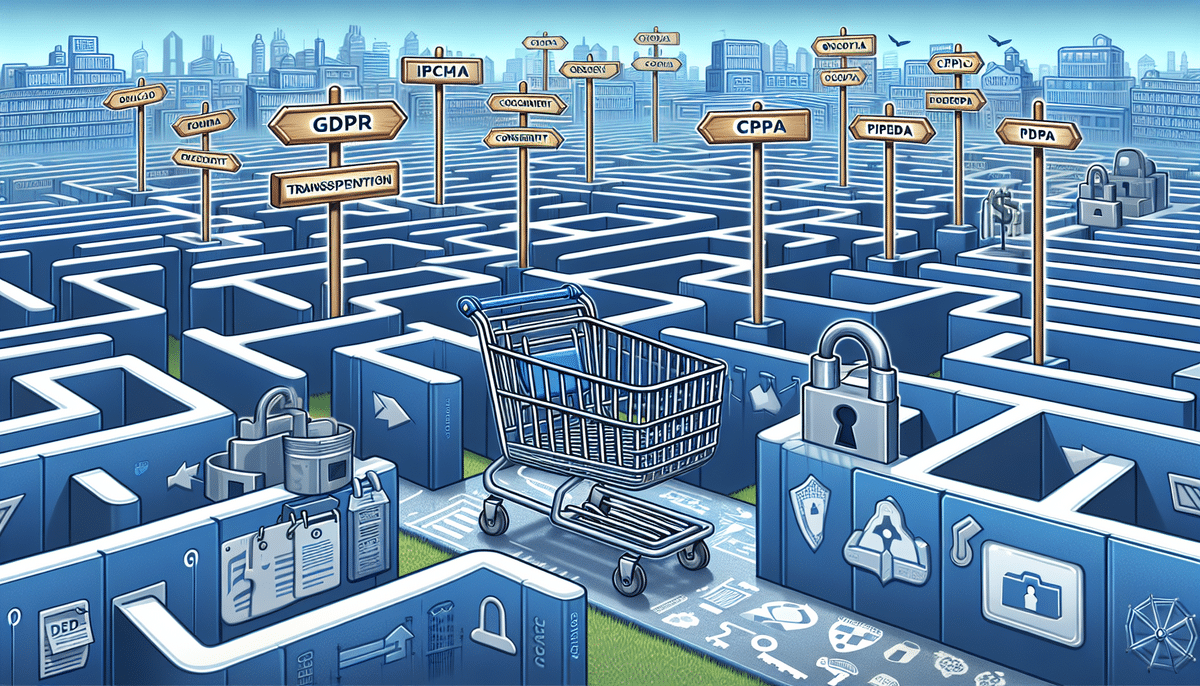Ecommerce Glossary: A Comprehensive Guide for Ecommerce Business Owners (Part 1)
Welcome to our comprehensive guide to the ecommerce glossary. Ecommerce has become an essential part of the business world, and with the rise of online shopping, it is more important than ever for business owners to have a deep understanding of ecommerce terminology, concepts, and best practices. In this guide, we will explore the fundamentals of ecommerce, its significance for business owners, and provide a step-by-step guide to setting up an ecommerce website. We will also delve into ecommerce payment gateways, shipping and fulfillment, managing customer data and privacy, and maximizing sales on your ecommerce site. Let’s get started!
Introduction to Ecommerce
Understanding the Basics
Ecommerce, short for Electronic Commerce, is the buying and selling of goods or services over the internet. It encompasses online shopping, electronic payments, and electronic data exchange. Ecommerce can be categorized into several types, including B2C (business-to-consumer), B2B (business-to-business), C2B (consumer-to-business), and C2C (consumer-to-consumer).
The growth of ecommerce has been remarkable, with global online sales projected to reach approximately $6.3 trillion by 2024. This surge is fueled by increased internet penetration, the rise of mobile commerce, and the convenience and cost savings offered by online shopping.
One of the key advantages of ecommerce is the ability to reach a global audience. With a website and online store, businesses can sell their products or services to customers worldwide without the need for a physical presence in each location. This opens up new markets and opportunities for businesses of all sizes, from small startups to large multinational corporations.
However, ecommerce also presents unique challenges, such as the necessity for secure online payment systems, effective logistics and shipping solutions, and the need to build trust with customers who may never have interacted with the business in person. Therefore, it is crucial for businesses to carefully consider their ecommerce strategy and invest in the necessary resources and infrastructure to ensure success.
The Importance of Ecommerce for Business Owners
Ecommerce has become increasingly vital for business owners, whether they run a small business or a large corporation. With the shift in consumer behavior towards online shopping, businesses without an ecommerce presence are likely to miss out on potential customers and revenue. Ecommerce also offers businesses the opportunity to expand their reach beyond local markets to a global scale.
Ecommerce can help businesses reduce overhead costs associated with a physical storefront and can offer higher profit margins. Additionally, ecommerce allows for greater personalization and targeting of marketing efforts, resulting in better customer engagement.
Another significant advantage of ecommerce is the ability to gather and analyze customer data. Businesses can track customer behavior, preferences, and purchase history, enabling them to tailor their products and services to better meet customer needs. This data can also be leveraged to create targeted marketing campaigns and improve overall business strategies.
Setting Up Your Ecommerce Website
Step-by-Step Guide
- Choose a domain name and reliable hosting provider.
- Select and install an ecommerce platform such as Shopify or WooCommerce.
- Design your website, including selecting a theme, logo, and color scheme.
- Set up your product catalog, including product descriptions, images, and pricing.
- Configure your payment methods and shipping settings.
- Add security features such as SSL certificates and firewalls.
Setting up an ecommerce website is an ongoing process. Regular updates and maintenance are necessary to keep up with the latest trends and technologies. This includes adding new products, optimizing your website for search engines, and enhancing the user experience. Monitoring your website's performance and analytics is also crucial to identify areas for improvement and make data-driven decisions.
Choosing the Right Ecommerce Platform for Your Business
Selecting the appropriate ecommerce platform is essential for building a successful online store. Various platforms are available, each with its strengths and weaknesses. Factors to consider when choosing an ecommerce platform include ease of use, scalability, customization options, and pricing.
Some popular ecommerce platforms include:
- Shopify: An all-in-one solution known for its ease of use and excellent customer support.
- WooCommerce: An open-source platform that offers extensive customization options.
- BigCommerce: A scalable platform designed for large businesses.
- Magento: A popular platform for building complex ecommerce websites.
- PrestaShop: An open-source platform with a wide range of features.
Consider the specific needs of your business when choosing an ecommerce platform. For instance, if you sell digital products, you may prefer a platform that offers secure file downloads. If you operate a brick-and-mortar store, you might want a platform that integrates seamlessly with your point-of-sale system. Additionally, evaluate the technical expertise required to set up and maintain the platform, as well as the availability of third-party plugins and integrations.
Essential Features Your Ecommerce Website Must Have
To ensure a seamless user experience and optimize conversions, every ecommerce website should include the following essential features:
- An intuitive navigation menu
- Clear and detailed product descriptions
- High-quality product images and videos
- A user-friendly shopping cart and checkout process
- Multiple payment options
- Secure transactions
- An SSL certificate to ensure data security
- A responsive design that functions well on all devices
Enhancing the user experience further, consider adding a search bar to allow users to quickly find the products they are looking for. This can save time and increase the likelihood of purchases.
Customer reviews and ratings are also invaluable. They help build trust and credibility with potential customers, as they can see feedback from others about your products and services. Additionally, customer reviews provide valuable insights that can help you improve your offerings and address any issues.
Optimizing Your Ecommerce Site
Search Engine Optimization (SEO)
Search Engine Optimization (SEO) is the process of improving your website's visibility and ranking on search engine results pages (SERPs). Optimizing your ecommerce site for SEO can enhance its organic visibility, driving more traffic and sales. Key steps to optimize your ecommerce site for SEO include:
- Conducting thorough keyword research to identify relevant search terms.
- Optimizing product descriptions and titles with targeted keywords.
- Structuring URLs to be clean and keyword-rich.
- Using header tags (H1, H2, H3) effectively to organize content.
- Crafting compelling meta descriptions for each page.
- Building quality backlinks from reputable sources.
Additionally, ensure that your website is mobile-friendly. With the increasing use of mobile devices for online shopping, a responsive design, fast loading times, and easy navigation on mobile devices are crucial. A mobile-friendly site not only improves user experience but also boosts your rankings on search engine results pages.
Conversion Rate Optimization (CRO)
Conversion Rate Optimization (CRO) involves increasing the percentage of website visitors who take a desired action, such as making a purchase. Here are some tips to maximize sales on your ecommerce site:
- Create a sense of urgency with limited-time offers and scarcity tactics.
- Utilize social proof, such as customer reviews and ratings, to build trust.
- Optimize product pages for easy navigation and clear information.
- Simplify the checkout process to reduce friction.
- Offer promotions and discounts to encourage purchases.
- Provide excellent customer service to enhance customer satisfaction.
Managing Ecommerce Operations
Understanding Ecommerce Payment Gateways and Options
Ecommerce payment gateways are vital for securely handling online transactions. They authorize the transfer of funds between the buyer’s and seller’s accounts. Several payment gateway options are available, including:
When choosing a payment gateway, consider the level of security it provides. Look for gateways that use encryption and tokenization to protect sensitive customer information. Additionally, some gateways offer fraud detection and prevention tools to safeguard your business from fraudulent transactions.
Ease of use for both you and your customers is another critical factor. Some payment gateways offer a streamlined checkout process with minimal steps, while others may require customers to create an account or navigate through multiple pages. Selecting a payment gateway that provides a seamless and user-friendly experience can significantly impact your conversion rates and the overall success of your ecommerce business.
Ecommerce Shipping and Fulfillment: Best Practices
Shipping and fulfillment are crucial aspects of ecommerce that can significantly influence the online shopping experience. Implementing best practices in these areas can enhance customer satisfaction and retention. Here are some best practices for ecommerce shipping and fulfillment:
- Offer multiple shipping options and provide tracking information.
- Provide accurate delivery estimates to set clear customer expectations.
- Partner with reliable carriers to ensure timely and safe deliveries.
- Maintain clear communication with customers throughout the fulfillment process.
- Properly pack and label products to ensure they reach customers in perfect condition.
Managing Customer Data and Privacy
Protecting customer data is paramount for ecommerce businesses. Ensure that all collected data is stored securely and that customer information is protected from unauthorized access. It is also essential to comply with data privacy regulations such as the General Data Protection Regulation (GDPR) and the California Consumer Privacy Act (CCPA). Providing customers with transparent and easy-to-understand privacy policies fosters trust and demonstrates your commitment to data security.
Overcoming Common Challenges
Ecommerce business owners often face several challenges, including cart abandonment, low conversion rates, and high shipping and fulfillment costs. To overcome these challenges, consider implementing the following strategies:
- Offer free shipping to reduce one of the primary reasons for cart abandonment.
- Improve the checkout process by minimizing the number of steps and eliminating unnecessary fields.
- Retarget customers who abandon their carts through email marketing campaigns.
- Optimize product pages with high-quality images, detailed descriptions, and customer reviews to enhance credibility.
- Streamline shipping and fulfillment operations by partnering with efficient carriers and using fulfillment software.
Future Trends in Ecommerce
The ecommerce industry is continually evolving, and staying ahead of the latest trends is essential for maintaining a competitive edge. Here are some future ecommerce trends that business owners should watch:
- The rise of voice-operated ecommerce, enabling users to shop using voice commands.
- Increased use of augmented reality (AR) and virtual reality (VR) in online shopping to enhance the customer experience.
- Growth of personalized shopping experiences through advanced data analytics and AI.
- Increased adoption of blockchain technology in ecommerce for enhanced security and transparency.
Conclusion: Key Takeaways from This Comprehensive Guide to Ecommerce Glossary
In conclusion, ecommerce is a fundamental component of the modern business landscape, and its significance is poised to grow in the coming years. Building a successful ecommerce website requires meticulous planning and execution, including selecting the right platform, optimizing for SEO, providing secure payment gateways, and offering efficient shipping and fulfillment options. By focusing on these areas and keeping abreast of the latest trends and best practices, ecommerce business owners can maximize their success and drive substantial growth for their businesses.






















